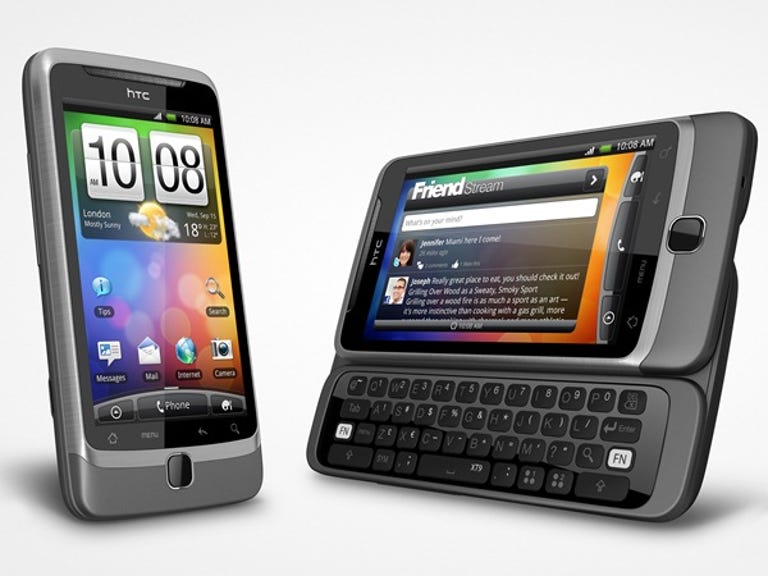 Why You Can Trust CNET
Why You Can Trust CNET HTC Desire Z review: HTC Desire Z
If you're looking for an Android with a keyboard, the Desire Z is highly recommended — especially if you don't plan to use your phone as a multimedia hub.
Design
Google has worked hard in the latest releases of Android to bolster the platform's appeal to business users, but with the jolly green robot as mascot this platform still tends to appeal to geeks and gamers more than to the BlackBerry set. The HTC Desire Z could change this, with an excellent QWERTY keyboard offering something we don't often see paired with Google's system.
The Good
The Bad
The Bottom Line
Android is coming up on its third birthday as a commercial product, and yet a scan over the dozens of Android releases up to now reveals a severe shortage of physical keyboards. Motorola is far in front with 14 QWERTY Androids (only five of which have made it to Australia), but for HTC, a leader in the Android brigade, the Desire Z is only the second keyboard phone after the HTC Dream. To set this release apart, HTC's designers have attempted to solve a problem we see all too often with QWERTY slider handsets: how to move the screen into a position where it doesn't obstruct the top row of the keyboard.
The solution is rather clever: an ingenious design HTC calls the "Z-hinge". When you slide this phone open the screen is effectively lifted by the Z-hinge and placed in line, and very nearly flush, with the bottom half of the handset. This reveals an excellent chiclet-design keyboard, where each key has a little breathing room from its neighbour.

HTC's clever Z-hinge mid-action.
(Credit: CBSi)
The physical aesthetics of the Desire Z are among the best of the HTC range. The handset maintains the now-familiar HTC design profile, but its mix of brushed aluminium and light slate-coloured soft-touch plastic gives the Z a brighter, more chic appearance than you get with either the Desire HD or with the HTC Windows Phone handsets.
User experience
If you've been watching the progress of HTC's Sense UI, then you're probably familiar with the user experience of the Desire Z. In many ways, it is identical to the version of Sense UI you get on the Desire HD. This Sense UI version 2.1 adds to its predecessor with customisation options unmatched by any other Android maker in the market to date. Using the HTC Hub you can change the phone's Skin, effectively change the colour palette of the phone across the UI, download ringtone packs to update all phone sounds in one action and apply any of the 72 HTC-designed home screen widgets.
Sense 2.1 also adds a multitasking manager into the Android notifications panel, allowing you to move between your most recently opened apps by scrolling through a horizontal list above your current notifications.
If there's one element of the UI we'd love HTC to take a crack at next, it's the layout of the Application Drawer. On the Desire Z the App Drawer remains the same as it has been since the first HTC releases, while other Android makers like Samsung have long since looked to an iPhone-esque horizontal app layout. This is a small issue to be sure, but we find the App Drawer can become a little unruly once you've downloaded several dozen new apps to the phone.
Media and the web
With innovations in the UI and the handset design, we weren't too surprised to see that the Desire Z doesn't break any new ground in either areas of multimedia or web browsing. The stock Android web browsing experience is used here, and our tests show it as being on par with the Desire HD, though a little slower with its lower processor clock speed.
We've read in several places that the Desire Z should support DivX and Xvid media files, but the only video file types we've managed to play on this handset are MP4 and WMV. We also struggled to use the HTC Connected Media DLNA file sharing app. In theory it should be as simple as having two DLNA-compatible devices on the same Wi-Fi network, but regardless of which devices we tried to connect to, the app simply couldn't find them.
The 5-megapixel camera on the Desire Z is only an average camera phone. Though it features an LED photolight and auto-focus, plus a range of nifty photo filters, the photos we took mostly showed soft focus and a gentle pink hue moving the pics away from a natural reproduction of colour.
A photo taken with the Desire Z. Lol.
(Credit: CBSi)
Performance
Without this focus on multimedia, HTC hasn't put its pedal to the metal with the hardware in the Z, though it hasn't skimped too much either. Opting for a Qualcomm Scorpion, the phone is powered by an 800MHz processor and an Adreno 205 GPU plus 512MB RAM. This combination, especially with the GPU, delivered some excellent benchmarking results, but we have noticed infrequent moments of animation jutter when navigating the phone's UI.
The most common complaint we've heard about the Desire HD is in regards to what many users consider poor battery life, where the battery charge isn't lasting until the end of their day. The Desire Z is in much the same boat; we managed to drain the battery easily with a decent day of use, and managed only a day and a half with what we'd consider light usage.
Overall
The combination of HTC Sense with the excellent QWERTY keyboard produces a handset quite unlike anything else available at this time. We certainly wouldn't recommend the Z for users looking for a media-sharing hub for their home entertainment system, and the camera isn't great, but these issues will be overlooked by users looking for a strong messaging device for work and social media.


